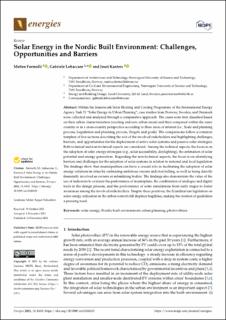| dc.description.abstract | Within the framework Solar Heating and Cooling Programme of the International Energy Agency Task 51 “Solar Energy in Urban Planning”, case studies from Norway, Sweden, and Denmark were collected and analyzed through a comparative approach. The cases were first classified based on their urban characterization (existing and new urban areas) and then compared within the same country or in a cross-country perspective according to three areas of interest (i.e., Scale and planning process, Legislation and planning process, Targets and goals). The comparisons follow a common template of five sections describing the role of the involved stakeholders and highlighting challenges, barriers, and opportunities for the deployment of active solar systems and passive solar strategies. Both technical and non-technical aspects are considered. Among the technical aspects, the focus is on the adoption of solar energy strategies (e.g., solar accessibility, daylighting), the estimation of solar potential and energy generation. Regarding the non-technical aspects, the focus is on identifying barriers and challenges for the adoption of solar systems in relation to national and local legislation. The findings show that municipalities can have a crucial role in facilitating the adoption of solar energy solutions in cities by embracing ambitious visions and storytelling, as well as being directly financially involved as owners or subsidizing bodies. The findings also demonstrate the value of the use of indicators to evaluate the performance of masterplans, the combination of analogue and digital tools in the design process, and the performance of solar simulations from early stages to foster awareness among the involved stakeholders. Despite these positives, the Scandinavian legislation on solar energy utilization in the urban context still displays fragilities, making the creation of guidelines a pressing need. | en_US |

